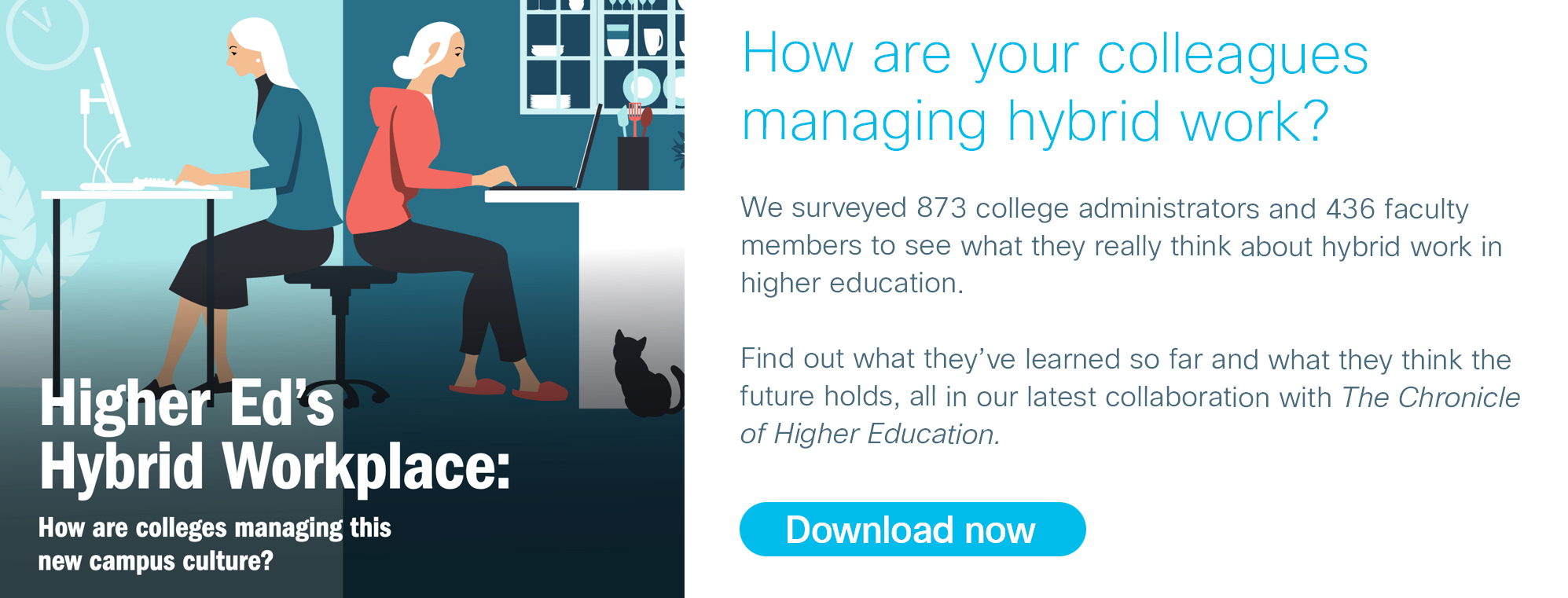- “생성형 AI, 전 산업서 직원 생산성, 임금, 가치 개선 중” PwC 조사
- "2024년 국내 서버시장 매출 5조 원··· 72.7% 성장" 한국IDC
- NotebookLM now lets you share your notebooks with anyone with a single link. Here's how
- Cornelis Networks offers alternative to Infiniband or Ethernet for HPC and AI networks
- Skip the iPad Pro and save $50 on Apple's newest 11th Gen iPad right now
Hybrid Work in Higher Education: What’s Next?

At this year’s EDUCAUSE, I sat down with Webster University and Collin College for a discussion hosted by The Chronicle of Higher Education. In our conversation we explored the possibilities offered by hybrid campuses, including opportunities that sometimes go overlooked. We also discussed the results from a recent The Chronicle of Higher Education survey that can help our industry better understand where hybrid stands today with faculty and administration.
Four key areas of hybrid work in higher education
Together with my friends from Webster University and Collin College, we focused on four areas of hybrid work in higher education that are key to how institutions approach hybrid campuses. These include:
- Student experience – Building a frictionless experience for students, faculty, and administration increases everyone’s success while delivering enhanced learning environments that can also help improve student retention as we face the approaching enrollment cliff in 2025.
- Staff and faculty remote work – Colleges and universities fall on a spectrum in terms of the extent to which they embrace a remote or hybrid workforce. Campuses, by their very nature of being a community of learners, are different from companies and the same remote work policies and protocols that work in business don’t always directly translate to higher education. However, like private sector companies, institutions of higher education are grappling with the set up that works best for their mission and goals.
- Student services – Offering hybrid services gives institutions of higher education the power to meet students’ needs faster and on-demand. This unlocks the world of high-value services that today’s students not only seek out but expect, including health counseling, financial services, and academic advising – all in a hybrid mode, at scale, and without disruption.
- Hybrid/online education – Higher education has a real need for their IT offerings to match the advanced expectations of tech-savvy students. That means delivering high-quality experiences for all stakeholders (including faculty, staff, and partners). To do so, schools must have the capability to successfully sustain their virtual environments end-to-end, regardless of a user’s time, location, device, and purpose – on campus and beyond.
Get the data: What we heard
To better understand how institutions are approaching hybrid work, we recently collaborated with The Chronicle of Higher Education to conduct a national survey (download now) of 873 college administrators and 436 faculty members, offering them the chance to share their perspectives on their own institutions’ policies for hybrid work in higher education, and how they are managing this new and evolving aspect of their campus culture.
While reviewing the survey results, there were several takeaways that really stood out to me and my colleagues, including:
- The top 3 reasons institutions went hybrid were staff focused, rather than student:
- Benefits to staff and faculty morale (73%)
- Better work environment for staff (70%)
- To recruit faculty and staff (45%).
- 52% of academic and administrative leaders would prefer for their institution to offer a hybrid work option.
- The top 3 roles or offices on campus that have an option for fully remote work include: IT 47%, faculty 35%, fundraising/development/alumni relations 24%.
- 93% of academic and administrative leaders and 84% of faculty strongly agree or somewhat agree that a hybrid work environment benefits employee morale.
- 89% of academic and administrative leaders and 82% of faculty strongly agree or somewhat agree that having a remote work option has improved their work-life balance.
At the end of the day, we know that hybrid is here to stay
Cisco is committed to powering inclusive learning for all. We believe that education is not about where you learn; it’s about what you learn. We are guided by the vision that all students can have equal access to education, no matter where they are. Learn how Cisco is working with institutions of higher education every day to help them meet the hybrid expectations of students and staff.
Share:


